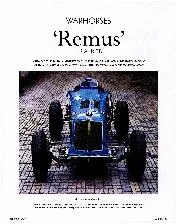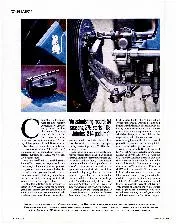

'Remus'
Warhorses Arguably the most-raced car in the world, Remus has been out in almost every season since 1936. Gordon Cruickshank investigates Could this be 'the most raced car in the…
World’s Record NonStop Fliht FROM CRANWELL TO WALVIS BAY, SOUTH WEST AFRICA, A DISTANCE OF 5,340 MILES IN 57 HOURS, 15 MINUTES.
HE capture last month of
the world’s non-stop straight-line record, following on the Speed and Height Records, establishes indubitably Great Britain’s position as the leading aircraft constructing country. The flight started from Cranwell, with Cape Town as its objective, but head winds increased the petrol consumption, forcing the pilots, Squadron Leader Gayford and Flight Lieutenant Nicholetts, to land at Walvis Bay, S.W. Africa. Even so they covered 5,340 miles on a Great Circle course, beating by 338 miles the distance of 5,012 miles put up by the Americans Boardman and Polands in. their flight from New York to Constantinople last year. The machine used was a Fairey monoplane similar to the one on which Jones-Williams and Jenkins flew to India in 1929. The cantilever wings are fabric-covered and inside them is stowed a thousand gallons of petrol. All the bracing is carried within the wing structure, and actually the only external wires are a pair which stay the tail-fin. The wheel track is exceptionally wide and the low pressure tyres and wheels are enclosed in spats. The pilot sits in front of the wing in a covered cockpit, and the second pilot who also acts as the navigator,
has a hammock chair in the interior of the fuselage. Windows under the wings and a transparent panel in the floor allow the navigator to observe the ground, and a hatch in the upper side of the fuselage allows observations of stars to be made. The machine was fitted with an automatic pilot, a device which keeps the machine on any predetermined course. This functioned perfectly in the earlier part of the trip, but the sand-laden winds of Nigeria upset its working, accounting for the deviation from the proper course which occurred shortly afterwards.
The Napier engine ran perfectly throughout the flight. It was a standard 570 h.p. Lion, slightly modified by raising the compression, while the carbuettors were carefully timed for economy.
Last year the machine was flown to Cairo in order to gain experience of long distance flying conditions. Comparisons of meteorological date had shown that February was the most suitable month to make the record attempt, for though conditions are generally rather unpleasant in Europe during that time, they are at their best over most of Africa. In South Africa of course, summer prevails during the northern winter.
The machine took off from Cranwell on February 6th at 7.15 a.m., and by 3 o’clock in the afternoon it had reached the south of France. From there the course lay over Sardinia to Tunis which was reached at 8 o’clock. The flyers were able to maintain their arranged speed of 110 m.p.h. and by 8 o’clock next morning were passing over Nigeria. Dust storms had been met with, upsetting the working of the automatic pilot, but the machine soon regained its course. Head winds and bad visibility further delayed the machine, but by midnight 4,000 miles had been flown, and the machine had passed Boma.
Further unfavourable weather prevailed and it was impossible to establish the aeroplane’s position, but during the next afternoon a sight was taken and • showed thd airmen that they were near Walvis Bay. Petrol by this time was almost exhausted, and they landed with only ten gallons left in the tanks. It was very disappointing not to have reached Cape Town, as the Fairey would undoubtedly have done given more favourable weather, but as it was the pilots had the satisfaction of beating the record of the American flyers by a comfortable margin, without having a moment’s anxiety on their long flight.